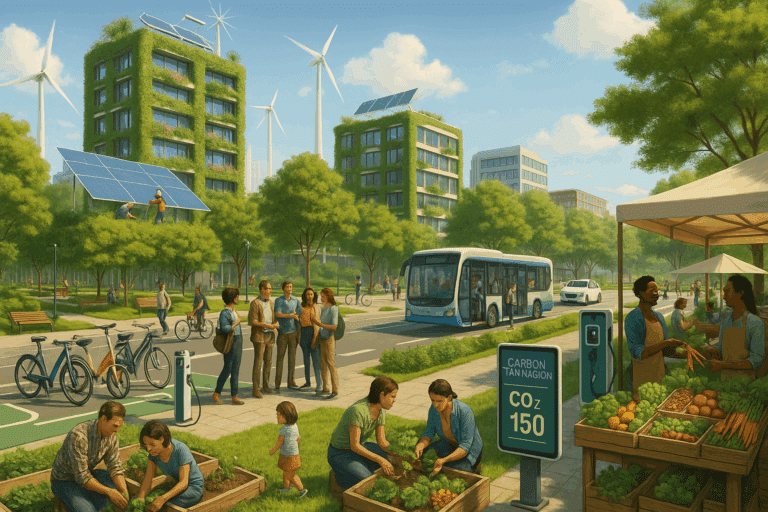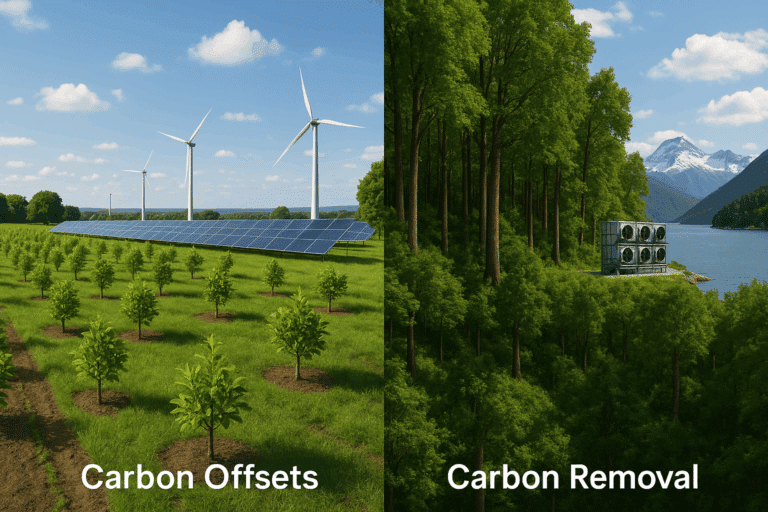It sounds utopian, doesn’t it? 💭 But the reality is, this scenario is not far-fetched. In fact, it’s something that we are moving towards, thanks to an initiative called the Science-Based Targets (SBTs).
The concept of Science-Based Targets (SBTs) has been growing in popularity over the past few years, and for good reason. This initiative is a joint venture between the Carbon Disclosure Project (CDP), the United Nations Global Compact (UNGC), World Resources Institute (WRI), and the World Wide Fund for Nature (WWF). The aim? To propel companies towards ambitious climate action by setting targets in line with the latest scientific research.
This article is about unlocking sustainable success through the Science-Based Targets Initiative. We will delve deep into understanding the very foundation of this initiative, exploring its roots, its significance in the modern corporate world, and how it is leading us towards a greener future. 🌍
Deep Dive into the Science-Based Targets Initiative
We will begin by shedding light on the concept of Science-Based Targets, explaining the science behind the initiative and its fundamental principles. The article will also highlight how the initiative is structured, detailing the process companies have to go through to get their targets validated. This will be crucial in understanding the nuts and bolts of how this initiative is helping to sculpt a sustainable future.
The Journey towards a Sustainable Future
We will then take a journey to explore the impact of the Science-Based Targets Initiative. We will look at some case studies of companies that have successfully implemented these targets, and the transformative effect this has had on their operations. This section will demonstrate the tangible benefits of adopting a science-based approach to sustainability, and will hopefully inspire others to follow suit. 🚀
Challenges and Opportunities
No initiative is without its challenges, and the Science-Based Targets Initiative is no exception. We will discuss some of the common hurdles companies face in adopting these targets, as well as potential solutions to overcome them. Simultaneously, we will explore the plethora of opportunities this initiative opens up for businesses, proving that sustainability and profitability are not mutually exclusive, but rather, intimately interconnected. 💡
This exploration will provide valuable insights for companies on the fence about setting science-based targets, and equip them with the necessary knowledge to overcome potential roadblocks. Furthermore, it will illustrate the wealth of opportunities that await companies willing to rise to the challenge of addressing climate change.
As we delve into the world of Science-Based Targets, it is crucial to keep in mind that this initiative is not just about environmental responsibility; it’s about future-proofing businesses. Companies that align their strategies with the demands of a low-carbon economy will not only contribute to mitigating climate change but will also uncover a world of opportunities for sustainable success.
Stay tuned as we unlock the secrets to sustainable success through the Science-Based Targets Initiative. Let’s embark on this journey towards a greener future together. 🌱
Understanding the Science-Based Targets Initiative (SBTi)
🌍 Em a world increasingly concerned about climate change, the Science-Based Targets Initiative (SBTi) emerges as a powerful player in the quest for a sustainable future. But what exactly is SBTi, and how does it work? This article delves into the specifics of this initiative, shedding light on its objectives, methodology, and impact on businesses and the environment.
SBTi is a collaboration between CDP, World Resources Institute (WRI), the World Wide Fund for Nature (WWF), and the United Nations Global Compact (UNGC). The initiative encourages companies to set science-based targets (SBTs) that align with the goals of the Paris Agreement—to limit global warming to well-below 2°C above pre-industrial levels and pursue efforts to limit warming to 1.5°C.
To fully understand the impact and importance of this initiative, it is necessary to delve into what science-based targets (SBTs) are, how they are calculated, and the role they play in mitigating climate change. To illustrate this, let’s use a relevant YouTube video titled “Science Based Targets Initiative – an introduction” by Carbon Trust. The video provides a clear, concise explanation of the initiative’s objectives and methodology.
🔬What are Science-Based Targets (SBTs)?
SBTs are emissions reduction targets in line with what the latest climate science says is necessary to meet the goals of the Paris Agreement. They provide a clearly defined pathway for companies to reduce greenhouse gas (GHG) emissions, helping prevent the worst impacts of climate change and future-proof business growth.
Targets are considered ‘science-based’ if they are in line with what the latest climate science deems necessary to meet the goals of the Paris Agreement – to limit global warming to well-below 2°C above pre-industrial levels and pursue efforts to limit warming to 1.5°C. To ensure the scientific integrity of these targets, SBTi has developed a detailed criteria and a set of resources and tools to help companies set their targets.
These targets are not one-size-fits-all. They vary based on industry, company size, and baseline emissions. For example, a manufacturing company’s SBTs would look vastly different from a software company’s targets. This flexibility allows companies of all sectors and sizes to participate and contribute to global emissions reduction.
Setting and Approving SBTs: A Detailed Process
Setting a science-based target is not a simple task. It involves a detailed process that includes four main steps: commit, develop, submit, and disclose. After a company publicly commits to set an SBT, they develop it using SBTi’s resources and tools. The target is then submitted to SBTi for validation. Upon approval, the company discloses their target through regular reporting.
However, not all targets get approved. SBTi uses a robust validation process to ensure the targets meet their strict criteria. The criteria differ depending on whether the target is in line with a well-below 2°C or 1.5°C pathway. For instance, companies aiming for a 1.5°C pathway need to have more aggressive targets.
Here’s a comparative table to illustrate this:
| Pathway | Required Reduction (by 2030) | Required Reduction (by 2050) |
|---|---|---|
| 1.5°C | At least 50% | Net-zero |
| Well-below 2°C | At least 30% | At least 80% |
SBTi’s Impact on Businesses and the Environment
The SBTi is leading the way towards a greener future by driving companies to take concrete action against climate change. Companies with approved SBTs are contributing to a larger global goal of limiting warming to 1.5°C or well-below 2°C, thus playing a critical role in mitigating the worst impacts of climate change.
But beyond the environmental benefits, setting SBTs also provides significant business advantages. Companies with SBTs often experience cost savings from energy and resource efficiency, enhanced reputation, increased investor confidence, and improved competitiveness. They are also better prepared for future regulations and policies on emissions reduction.
Despite the apparent benefits, setting SBTs is not without its challenges. It requires significant resources and commitment from the company. However, with the increasing urgency of climate change and the mounting pressure from consumers and investors for businesses to take action, the benefits of setting SBTs far outweigh the challenges.
The Future of SBTi and Sustainable Success
As of now, over 1,000 companies have committed to set SBTs, with hundreds more in the process of having their targets approved. This shows a promising trend towards a greener, more sustainable future. However, to truly turn the tide against climate change, more companies need to step up and set their own SBTs.
As we move forward, the SBTi will continue to play a critical role in guiding companies towards sustainable success. The initiative provides a clear, science-based pathway for companies to reduce their emissions, contributing to a larger global effort to mitigate climate change. It is a testament to the power of science, collaboration, and corporate responsibility in addressing one of the most pressing issues of our time.
Unlocking sustainable success starts with setting ambitious, science-based targets. The journey may be challenging, but with the guidance of SBTi, businesses are well-equipped to navigate the path towards a greener future. So, are you ready to take the first step? Begin by watching the aforementioned YouTube video, understand the SBTi, and start your journey towards sustainable success. 🌱

Conclusion
In this comprehensive article, we have journeyed through the exciting and challenging world of software engineering. The critical role of engineering principles in the field of Information Technology and the ways in which they enable us to create, design, and implement software systems effectively has been underscored. The essential concept of a Software Development Life Cycle (SDLC) was explained, with its crucial stages and the various methodologies such as the Waterfall, Agile, Iterative, and Spiral models. We delved into the importance of software testing and its types, like functional, non-functional, regression, and smoke testing. All these form the bedrock of software development, allowing us to enhance software quality, mitigate risks, and improve performance.
The discussion moved forward to understanding different software documentation types, their significance, and how they aid in the smooth functioning of a software project. We also emphasized the pivotal role of a technical writer in software development and how they contribute to simplifying complex ideas for diverse audiences.
We hope that this article has given you a comprehensive understanding of the subject matter. If you are a professional in the IT industry, a software engineering student, or someone interested in gaining insights into how software is developed, we believe you will find the contents of this article highly valuable.
In a world that is increasingly driven by technology, staying updated on the latest trends and acquiring new skills has become more important than ever. We urge you to revisit the concepts discussed, apply them to real-world scenarios, and engage in continuous learning to excel in this dynamic field. For more in-depth knowledge, we recommend the following resources: IEEE Explore, Science Direct, and Springer Link.
We welcome your thoughts, questions, and experiences in the comment section below. Please share this article with your colleagues, friends, and anyone who might benefit from it. We are always here to engage in meaningful discussions and learn together. Remember, every contribution helps us create a community where knowledge is shared, and everyone benefits.
Stay curious, keep learning, and remember, in the words of Steve Jobs, “The people who are crazy enough to think they can change the world are the ones who do.” 🌎✨ Let’s keep pushing the boundaries of what’s possible in software engineering together.
Thank you for taking the time to read this article, and we look forward to hearing your insights! 🙏🚀
References:
[post-views] [post_likes] [post_share]



